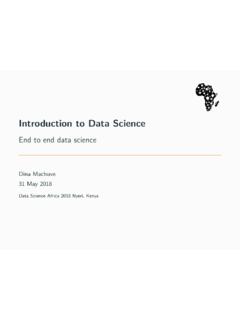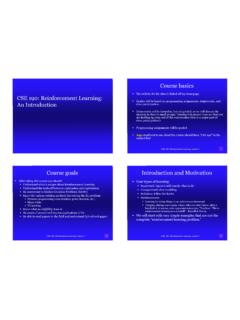Transcription of Introduction to Reinforcement Learning (RL)
1 Introduction to Reinforcement Learning (RL)Billy Okal Apple is RLReinforcement Learning is a paradigm for Learning to make a good sequence of decisionsReinforcement Learning in Context4 Unsupervised LearningSupervised LearningLabels for all samplesNo labelsReinforcement LearningSparse & delayed labelsReinforcement Learning in Context5 Unsupervised LearningSupervised LearningReinforcement LearningData OptimizationData OptimizationData Optimization Long-term consequences ExplorationRL agent takes an action in an environment environment responds with a feedback signal agent uses the feedback to decide on future actions6 Example applications of RL Games Go, video console games Robotics drone, mobile robot navigation Medicine administering trials Dialogue systems, chatbots Personalized web internet ads, news feeds Finance trading Process optimization DRAM, elevator dispatch 7 Example applications of RL TD-Gammon for the game backgammon Early 90s8366 CHAPTER 16.
2 APPLICATIONS AND CASE STUDIES white pieces move counterclockwise123456789101112181716151 413192021222324 black pieces move clockwiseFigure :A backgammon positionFor example, he could move two pieces from the 12 point, one to the 17 point, andone to the 14 point. White s objective is to advance all of his pieces into the lastquadrant (points 19 24) and then o the board. The first player to remove all hispieces wins. One complication is that the pieces interact as they pass each othergoing in di erent directions. For example, if it were black s move in Figure ,he could use the dice roll of 2 to move a piece from the 24 point to the 22 point, hitting the white piece there. Pieces that have been hit are placed on the bar inthe middle of the board (where we already see one previously hit black piece), fromwhence they reenter the race from the start.
3 However, if there are two pieces on apoint, then the opponent cannot move to that point; the pieces are protected frombeing hit. Thus, white cannot use his 5 2 dice roll to move either of his pieces onthe 1 point, because their possible resulting points are occupied by groups of blackpieces. Forming contiguous blocks of occupied points to block the opponent is oneof the elementary strategies of the involves several further complications, but the above descriptiongives the basic idea. With 30 pieces and 24 possible locations (26, counting thebar and o -the-board) it should be clear that the number of possible backgammonpositions is enormous, far more than the number of memory elements one couldhave in any physically realizable computer.
4 The number of moves possible fromeach position is also large. For a typical dice roll there might be 20 di erent waysof playing. In considering future moves, such as the response of the opponent, onemust consider the possible dice rolls as well. The result is that the game tree has ane ective branching factor of about 400. This is far too large to permit e ective useof the conventional heuristic search methods that have proved so e ective in gameslike chess and the other hand, the game is a good match to the capabilities of TD learningmethods. Although the game is highly stochastic, a complete description of thegame s state is available at all times. The game evolves over a sequence of movesand positions until finally ending in a win for one player or the other, ending thegame.
5 The outcome can be interpreted as a final reward to be predicted. On theExample applications of RL AlphaGo Very recent Combines RL with other Learning MASTERING THE GAME OF GO391blocked (Figure right). Other rules are needed to prevent infinite capturing/re-capturing loops. The game ends when neither player wishes to place another rules are simple, but they produce a very complex game that has had wideappeal for thousands of :A Go board :Go capturing rule. Left: the three white stones are not surrounded becausepoint X is unoccupied. Middle: if black places a stone on X, the three white stones arecaptured and removed from the board. Right: if white places a stone on point X first, thecapture is that produced strong play for other games, such as chess, have not workedas well for Go.
6 The search space for Go is significantly larger than that of chessbecause Go has a larger number of legal moves per position than chess ( 250 versus 35) and Go games tend to involve more moves than chess games ( 150 versus 80). But the size of the search space is not the major factor that makes Go sodi cult. Exhaustive search is infeasible for both chess and Go, and Go on smallerboards, , 9 9, has proven to be di cult as well. Experts agree that the majorstumbling block to creating stronger-than-amateur Go programs is the di culty ofdefining an adequate position evaluation function. A good evaluation function allowssearch to be truncated at a feasible depth by providing relatively easy-to-computepredictions of what deeper search would likely yield.
7 According to M uller (2002): No simple yet reasonable evaluation function will ever be found for Go. A majorstep forward was the Introduction of MCTS into Go programs, which led to a series ofsignificant advances in playing skill. The strongest programs at the time of AlphaGo sdevelopment all used MCTS. But master-level skill remained of RL tasks Interaction! When task requires making a sequence of decisions There is feedback resulting from the choice of state and/or actions Data is in the form of trajectories 10 Mathematical FormalismMarkov Decision Processes | Notation States: Actions: Transition/dynamics: Feedback (reward, cost): Note: time is usually assumed to evolve in discrete steps12S={s,s0}St,St+1A={a,a0}At,At+1Pr( St+1=s0|St=s,At=a)Pr(Rt=r|St=s)Pr(Rt=r|S t=s,At=a)Pr(Rt=r|St=s,At=a,St+1=s0)rewar d(state)reward(state, action)reward(state, action, next_state)transition(state, action)Markov Decision Processes | Building Blocks Return: the sum of rewards accumulated Discounting: future rewards are worth less than current ones Policy : a prescription for actions Value of a state.
8 State-value function (Q-function):13 (s) 2[0,1] :S A ![0,1]G=Rt+0+Rt+1+,..,+Rt+HG= 0Rt+0+ 1Rt+1+,..,+ HRt+H=1Xk=0 kRt+k+1V (s)=E [G|St=s]Q (s,a)=E [G|St=s,At=a]Markov Decision Processes | Prediction How to estimate the value of a policy: Monte Carlo average the values of states as the agent visits them. For infinite samples (state visitation) converges to the true value Dynamic programming exploits the recursive relation between successive state values, Backup values from future states to the present (s)V (s0)V (s)=E [Rt+ V (s0)|St=s,At=a,St+1=s0]Markov Decision Processes | Assessment/Evaluation Given two policies, Policy 1 is better than policy 2 iff What is the best/optimal policy? Has corresponding to the optimal value and Q functions, Extract policy from value or Q-function15 1, 2V 1(s)>V 2(s)8s2SV (s)=max 2 V (s) (s)=argmaxa2AQ (s,a)Q (s,a)=max 2 Q (s,a)Additional RL Terminologies Episodic vs continuous On-policy vs off-policy Greedy take the action providing maximum gain16 Markov Decision Processes | Model-based vs Model-free Model-based: Collect data and learn reasonable approximations of T and R then apply value iteration to find the optimal value function, from which the policy to use is then extracted.
9 Model-free: Directly estimate the value function or the optimal & LearningMarkov Decision Processes | Planning (1) Given a full MDP model, find the optimal policy (or value function) Value iteration algorithm1990 CHAPTER 4. DYNAMIC PROGRAMMINGV alue iterationInitialize arrayVarbitrarily ( ,V(s) = 0 for alls2S+)Repeat 0 For eachs2S:v V(s)V(s) maxaPs0,rp(s0,r|s,a) r+ V(s0) max( ,|v V(s)|)until < (a small positive number)Output a deterministic policy, , such that (s) = argmaxaPs0,rp(s0,r|s,a) r+ V(s0) in a sweep. The box shows a complete algorithm with this kind of iteration e ectively combines, in each of its sweeps, one sweep of policyevaluation and one sweep of policy improvement. Faster convergence is often achievedby interposing multiple policy evaluation sweeps between each policy improvementsweep.
10 In general, the entire class of truncated policy iteration algorithms can bethought of as sequences of sweeps, some of which use policy evaluation backups andsome of which use value iteration backups. Since the max operation in ( ) is theonly di erence between these backups, this just means that the max operation isadded to some sweeps of policy evaluation. All of these algorithms converge to anoptimal policy for discounted finite : Gambler s ProblemA gambler has the opportunity to make betson the outcomes of a sequence of coin flips. If the coin comes up heads, he wins asmany dollars as he has staked on that flip; if it is tails, he loses his stake. The gameends when the gambler wins by reaching his goal of $100, or loses by running out ofmoney.










